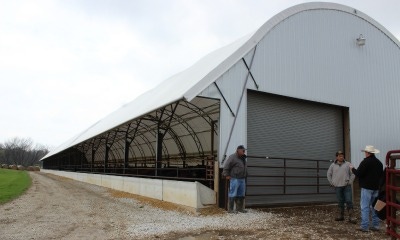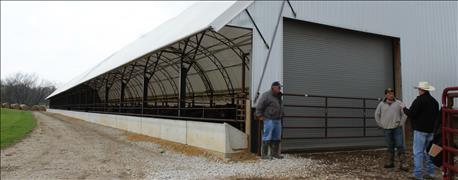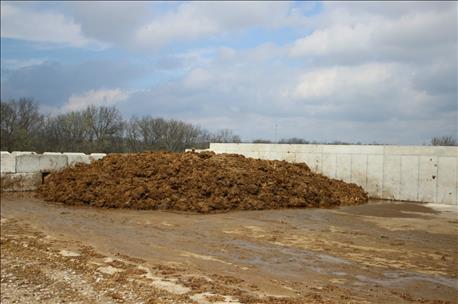
George and Danny Wassmann decided to take their beef cattle feeding operation under roof with a hoop building. But the new venture requires a little more manure management.
The new covered facility in Cooper County is 320 feet long and 36 feet wide with a 4-foot awning over the feed bunk. It has roughly 320 head of beef cattle capacity.
However, with an enclosed system, farmers should be prepared for manure that a covered feed yard generates. Hoop Beef Systems member service manager Jeff Windett says that storage is key.
"There will be times that you cannot get the manure onto the pasture because of weather," Windett explains. "You need to devise a plan for stock piling your manure."

MAKING MANURE: A hoop beef building will generate manure throughout the year. Farmers need to plan for removal and disposal. In many cases, it will require a storage area.
Here are 4 tips for handling manure from a hoob beef building:
1. Devise a plan for removal. They remove manure from concrete pad by the feed bunk and waterers once a week. However, as the cattle grow and produce more manure cleaning that area can be as often as every four days.
2. Create a holding area. The Wassmanns created a 60-foot concrete scrape pad at the end of the barn where manure is stored after cleaning the barn. The site can store up to six months' worth of manure.
3. Expect one large haul. Cows spend most of their time lying on a corn stalk or wheat straw pack that covers roughly 2/3 of the barn. Unexposed to the elements, it can remain in the building up to one year before changing. Typically, the family changes the pack with each new calf group. "We allow it to compost in place," George explains. "It does a great job of staying dry."

STOCK PILE: Manure from the Wassmann hoop beef operation is stored on a concrete pad at the end of the barn. It is then spread on to pastures and crop fields as the weather allows.
4. Consider where manure will go. The Wassmanns take the manure and spread it on crop or pasture ground. However, Windett says some beef producers are marketing manure to area farmers. He explains that manure has value making it a win-win for both beef and crop farmers. Talk with area farmers to gauge interest.
The payoff
Without the direct exposure extremes of heat and cold found in Missouri, the Wassmanns cattle are putting on more pounds in less time under roof. "We have seen a 15% boost in feed efficiency," Danny notes. "We are able to finish them earlier and with less feed."
The family uses 1/3 less feed to finish inside the barn rather than in their previous outside lots. The production benefits help balance the additional need to manage manure.
About the Author(s)
You May Also Like






